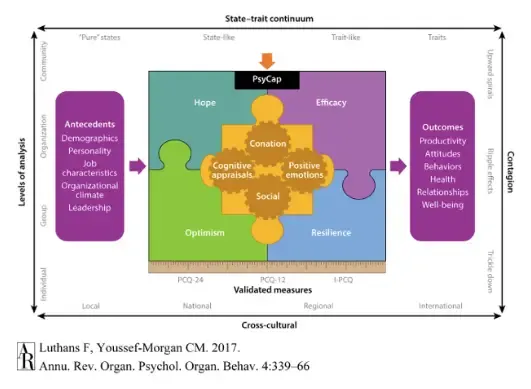Psycap 101: Your Guide to Increasing Psychological Capital
 Originally developed in an organizational context, the concept of Psychological Capital with its four pillars of Hope, Efficacy, Resilience, and Optimism (HERO) has been linked to job- as well as life satisfaction.
Originally developed in an organizational context, the concept of Psychological Capital with its four pillars of Hope, Efficacy, Resilience, and Optimism (HERO) has been linked to job- as well as life satisfaction.
While every component has its own characteristics and interventions, the concept of PsyCap is greater than the sum of its parts.
Based on appreciation and positive emotions, PsyCap is a core construct for wellbeing and thriving. This article outlines the four elements of PsyCap, looks at the value of the concept as a whole and aims to inspire its use in leadership and coaching.
Before you continue, we thought you might like to download our three Resilience Exercises for free. These engaging, science-based exercises will help you to effectively deal with difficult circumstances and give you the tools to improve the resilience of your clients, students, or employees.
This Article Contains:
Investing in People – A Source of Competitive Advantage
The concept of Psychological Capital (PsyCap) was originally designed for organizations. Pioneer Fred Luthans suggested that growth in organizations needs to focus on psychological rather than educational development. He argued that human resources can serve as a competitive advantage as they are more inimitable by competitors than physical, structural and financial resources.
Luthans argued that employees possess two types of knowledge: explicit and tacit knowledge. Explicit knowledge includes skills, abilities, and competencies derived from education and experience.
Tacit knowledge, on the other hand, is built over time through socialization into the organization. He claimed that tacit knowledge offers a long-term competitive advantage as it is unique, cumulative, interconnected and non-transferable to competitors.
Based on this idea, Luthans urged companies to invest in human capital management including building tacit knowledge rather than hiring a skilled temporary workforce (Fred Luthans & Youssef, 2004). Back then, the idea of investing in people for competitive advantage was considered ground-breaking.
A Concept for All Life Domains
Under the umbrella of positive organizational behavior (POB), the “study and application of positively oriented human resource strengths and psychological capacities”, Luthans developed the concept of Psychological Capital (PsyCap) as a source of competitive advantage.
In line with this idea, many studies have since confirmed that high levels of PsyCap are positively related to employee performance and job satisfaction, especially in the services industry (Abbas, Raja, Darr, & Bouckenooghe, 2012; Fred Luthans, Avolio, Avey, & Norman, 2007; Fred Luthans & Youssef, 2007; Youssef & Luthans, 2007).
What is more, employees who strive at work can be assumed to generally have a more fulfilling life due to the strong relationship between job and life satisfaction (Judge & Watanabe, 1993). Accordingly, PsyCap has been linked to outcomes of general importance for individuals.
High levels of PsyCap have been found to positively influence wellbeing, health outcomes such as lower BMI and cholesterol levels and satisfaction with one’s relationships (Lorenz, Beer, Pütz, & Heinitz, 2016). Using the concept of PsyCap, leaders and coaches can:
“leverage to tap into still largely uncharted territories of human strengths, thriving, and excellence”
(Fred Luthans & Youssef-Morgan, 2017).
Definition and Measurement of Psychological Capital (PsyCap)
Psychological Capital is defined as “an individual’s positive psychological state of development” (Fred Luthans, et al., 2007) which is characterized by having high levels of HERO; the four elements of Hope, (Self-)Efficacy, Resilience, and Optimism.
The concept of PsyCap has become even more relevant with recent findings in the area of neuroplasticity. Since our brain is malleable, PsyCap can be developed and strengthened. Further, PsyCap can be managed and assessed.
Several scales have been developed to measure PsyCap. The original scale developed by Luthans, Youssef and Avolio (2007) in the context of organizations is the Psychological Capital Questionnaire 24 (PCQ-24). For a more general application in all domains of life, Lorenz et al. (2016) developed the Compound PsyCap Scale (CPC-12), a twelve-item self-report scale.
Here is an overview of the concept of PsyCap:
Application of PsyCap in Leadership and Coaching
As Shawn Achor (2011) claims, we are successful when we are happy, not the other way around. So if we are more hopeful, efficacious, resilient and optimistic, we are more likely to “weather the storm” in a dynamic organizational or a challenging personal environment. Hence, the concept of Psychological Capital is equally important for coaches and leaders.
Here is an overview of the four components of PsyCap and the interventions which can be used to further build on this capital. It is important to keep in mind that the level of PsyCap as a whole has a stronger relationship than each of the four components individually, as will be discussed later.
Hope
Hope and optimism are both personality traits that have been linked to physiological and psychological wellbeing (Du, Bernardo, & Yeung, 2015). According to Rick Snyer et al. (1991 p. 257),
“hopeful thought reflects the belief that one can find pathways to desired goals and become motivated to use those pathways”.
Hence, hope is a cognitive process that motivates to find willpower (goal-directed determination) and waypower (planning of ways to meet goals) which leads to positive emotions (the expectation of meeting desired goals). Here is a two-minute video on Snyder’s hope theory:
We must accept finite disappointment but never lose infinite hope
Martin Luther King
How to Develop Hope
Enriching the following three components have found to be successful in developing hope:
1. Goal setting and perceived ability (pathway thoughts)
The concept of hope is strongly based on the belief that individuals want to achieve goals. Generally, approach-oriented goals (moving towards something) are emphasized over avoidance-oriented (moving away from something) goals.
In a work context, ideally, goals are specific, measurable, attainable, relevant and time-based as well as clearly communicated. Leaders can support employees by breaking down complex, difficult goals into bite-size portions. What is more, appreciating or even celebrating small milestones can be a key motivation for employees. They become more confident they can reach the goals (Fred Luthans & Youssef, 2004).
In coaching sessions, the goals themselves may not necessarily need to be defined as specific tasks. Rather, goals may lie in the desired change in behavior or emotional state
(Lippmann, 2013). Importantly, however, the current state, as well as the desired state, can be pinned on a scale of 0 – 10. To enhance goal-setting, coachees can be guided to develop a mental movie of how they will reach the desired goal (Fischer-Epe, 2016). This intervention strengthens the understanding of the goal and enhances the client’s belief that they can reach it.
2. Motivation (agency thoughts)
Autonomy and meaning have found to be key factors to create intrinsic motivation with employees.
Although clients generally decide for themselves what they would like to achieve through coaching, their goal needs to be validated as their own. Often, coachees confuse their goals with what they believe others would want them to achieve. As a result, coachees may lack a sense of motivation towards a goal they do not “own”.
In our Toolkit you will find the “Hope Map” exercise which will is designed to teach pathway thinking to clients to help unlock the motivating energy of hope.
Efficacy

Whether we have the confidence to take on and put in the necessary effort to succeed at challenging tasks determines how we feel, think and motivate ourselves.
The belief that we can produce the desired effect is a major incentive to act in the first place. The higher our efficacy expectancy, the harder we will work to achieve our goals, leading to a higher probability of success.
There are two key ingredients to self-efficacy:
1. Outcome expectancy (examination of what needs to be done)
2. Efficacy expectancy (examination of our own capability to do what needs to be done)
Here is a great video which explains Bandura’s concept of self-efficacy in only 6 minutes:
Believe you can and you’re halfway there.
T. Roosevelt
How to Develop Self-efficacy
Bandura (1994) found that our level of self-efficacy is affected by the following processes:
- Cognitive (thoughts shape reality)
- Motivational (expected outcomes based on our beliefs shape our motivation)
- Affective (perceived coping self-efficacy regulates avoidance behavior)
- Selection (we only expose ourselves to situations we believe we can master)
Here are four ways to strengthen efficacy:
1. Focus on past success (mastery experiences)
Looking at past success is a robust way to increase levels of self-efficacy. In a coaching or leadership environment, it is often about finding (increasing awareness) and appreciating success stories rather than creating them.
Especially clients with a high external locus of control tend to lend positive events to external factors or luck (Ajzen, 2002). Therefore, by outlining the factors, traits, and strengths which contributed to the success we can create mastery experiences which may lead to higher levels of self-efficacy.
2. Copy other people (social modeling)
Seeing people in similar situations overcoming obstacles increases the belief that one, too, can do it. Importantly, the models need to be perceived as similar to oneself in order to feel a strong sense of confidence in one’s capabilities.
Again, clients with low self-esteem are likely to perceive other people to have a greater skills repertoire than they themselves. These thought patterns need to be challenged in order for social modeling to be successful.
3. Create situations for success (social persuasion)
While verbal persuasion can be a great source of confidence, it can be difficult to overcome self-doubts. As leaders, in addition to verbal persuasion, we can structure situations for employees in ways that bring success and in turn avoid placing people in situations prematurely where they are likely to fail.
4. Reframe negative experience (psychological responses)
How we interpret our physical and emotional reaction in situations of stress and tension affects how we judge fatigue and our vulnerability to stress. People with high levels of self-efficacy are able to see a state of affective arousal as an energizing facilitator of performance.
Similar to Carol Dweck’s concept of mindset, this shows that how we perceive obstacles has an impact on how we deal with them. We all experience fatigue, resistance and fear at times.
By discussing psychological responses with a client or employee they may be able to see a state of emotional arousal before a presentation as a sign of anticipation and curiosity rather than weakness can greatly increase performance and therefore self-efficacy.
Resilience

We all experience hardship and rejection in life. But what makes us successful and striving is not defined by how often we get rejected but how often we bounce back and give it one more go. In essence, resilience is about learning to fall.
Our greatest glory is not in never falling, but in rising every time we fall.
Confucius
How to Develop Resilience
According to Senior Editor Diane Coutu (2002), resilience is a combination of the following three capacities:
1. Face Reality
In situations of despair and hopelessness, the best way to cope is to face reality rather than thinking positively. If we expect things to get better soon, we may lose the energy and hope when the situation does not change quickly enough. Therefore, in difficult situations, facing and accepting reality may create a better basis to endure hardship for the time it lasts.
2. Search for Meaning
Being able to find meaning even when facing a fate that cannot be changed is at the core of resilience. Having a purpose in life is one of the five pillars of Seligman’s in his PERMA model of happiness (Slavin, Schindler, Chibnall, Fendell, & Shoss, 2012). Helping coachees and employees to find or create meaning strengthens their level of resilience.
3. Improvise
The ability to deal with a situation with whatever we have at hand is a strong predictor of our ability to bounce back from adversity. It is not so much the tools we are given, but the ability to improvise and find new ways to reach a goal.
Leaders are role models for their employees and their ability to improvise is crucial. In a coaching session, brainstorming different ideas to solve a problem can strengthen the coachee in their ability to improvise.
According to Hugo Alberts, resilience training is possible and he presents a powerful Realizing Resilience Masterclass for practitioners full of gems such as videos, presentations, and handbooks.
Optimism

People with a low external locus of control tend to internalize positive events and take the credit.
They believe that in order for something good to happen, they need to work for it. Optimists, however, believe that good things will happen to them in the future, no matter what.
Live life as if everything is rigged in your favor.
Rumi
How to Develop Optimism
Developing optimism is all about changing focus. It can be developed by exercises of accepting the past, appreciating the moment and viewing the future as a source of opportunity. The way we assess past events has a major impact on how we predict the future.
Reframing is a great technique with coaches as well as employees to achieve a change in vision and it can be used by leaders in the context of organizations as well as in coaching and therapy sessions.
In our Positive Psychology Toolkit© you will find the exercise “The Best Possible Self (BPS)” which can be used to change the mindset and increase optimism.
PsyCap Greater than its Parts
The concept of Psychological Capital is made up of the four elements of Hope, Efficacy, Resilience, and Optimism, with the commonality of appreciation and the positive appraisal of events. Developing one resource tends to boost the other ones as well.
While there is a lot to be said for every one of the components, the concept of Psycap is greater than the sum of its parts. Hobfoll (2002) points out a tendency for “enrichment of all resources among those who possess a solid resource reservoir”. Hence, the four components form a higher-order construct which maximizes its potential when all four areas are taken into consideration.
Recently, there have been new ways of including all four elements in interventions. Luthans & Youssef (2017) point to gamification as a way to train all four capacities. The use of positive video games, inspirational YouTube videos, and Apps such as “Happify” is being tested to increase engagement and sustainability of PsyCap development.
As we spread our attention across all four areas of PsyCap and use new technology to create fun interventions we can create real value towards job and life satisfaction.
For an overview of Luthans & Youssef’s PsyCap intervention tools check this website out.
A Take-Home Message
The concept of Psychological Capital is strongly linked to increased wellbeing, work, and life satisfaction. Developing even one the four areas of hope, efficacy, resilience, and optimism in employees and coachees has a positive effect on the other elements.
Many of the tools in positive psychology are based on appreciation and are closely linked to this concept and therefore indirectly stimulate HERO. For the best outcome use interventions which influence more than one area.
So what is the main intervention to develop PsyCap? As it is often the case, the simple tools have the most impact. Making employees and coachees aware of the concept and appreciating their level of HERO may already have a positive effect. Because becoming aware of this great source of capital, this great HERO we all carry within is a powerful intervention in itself.
We hope you enjoyed reading this article. Don’t forget to download our three Resilience Exercises for free.
- Abbas, M., Raja, U., Darr, W. A., & Bouckenooghe, D. (2012). Combined Effects of Perceived Politics and Psychological Capital on Job Satisfaction, Turnover Intentions, and Performance. Journal of Management, 40(7), 1813–1830.
- Achor, S. (2011). The Happiness Advantage: The Seven Principles of Positive Psychology That Fuel Success and Performance at Work. London, UK: Random House.
- Ajzen, I. (2002). Perceived Behavioural Control, Self-Efficacy, Locus of Control, and The Theory of Planned Behaviour. Journal of Applied Social Psychology, 32(4), 665-683.
- Bandura, A. (1994). Self-efficacy. Encyclopedia of human behavior, 4, 71-81.
- Bandura, A. (1997). Self-efficacy: The exercise of control. New York: W.H. Freeman.
- Coutu, D. L. (2002). How Resilience Works. Harvard Business Review, May, 1 – 8.
- Du, H., Bernardo, A. B. I., & Yeung, S. S. (2015). Locus-of-hope and life satisfaction: The mediating roles of personal self-esteem and relational self-esteem. Personality and Individual Differences, 83, 228-233.
- Fischer-Epe, M. (2016). Coaching (Vol. 5). Munich: Rowohlt.
- Hobfoll, S. E. (2002). Social and Psychological Resources and Adaptation. Review of General Psychology, 6(4), 308-324.
- Judge, T. A., & Watanabe, S. (1993). Another Look at the Job Satisfaction-Life Satisfaction Relationship. Journal of Applied Psychology, 78(6), 939-948.
- Lippmann, E. (2013). Coaching (Vol. 3). Berlin-Heidelberg: Springer-Verlag.
- Lorenz, T., Beer, C., Pütz, J., & Heinitz, K. (2016). Measuring Psychological Capital: Construction and Validation of the Compound PsyCap Scale. Plos One, 11(4).
- Luthans, F. (2002). The need for and meaning of positive organizational behaviour. Journal of Organizational Behaviour, 23, 695-706.
- Luthans, F., Avolio, B. J., Avey, J. B., & Norman, S. M. (2007). Positive Psychological capital: measurement and relationsihp with performance and satisfaction. Personnel Psychology, 60, 541-572.
- Luthans, F., & Youssef-Morgan, C. M. (2017). Psychological Capital: An Evidence-Based Positive Approach. Annual Review of Organizational Psychology and Organizational Behavior, 4, 339-366.
- Luthans, F., & Youssef, C. M. (2004). Human, Social and Now Positive Psychological Capital Management: Investing in People for Competitive Advantage. Organizational Dynamics, 33(2), 143-160.
- Luthans, F., & Youssef, C. M. (2007). Emerging Positive Organizational Behavior Journal of Management, 6, 321-349.
- Reivich, K., & Shatté, A. (2002). The resilience factor: 7 essential skills for overcoming life’s inevitable obstacles. New York: Broadway Books.
- Slavin, S. J., Schindler, D., Chibnall, J. T., Fendell, G., & Shoss, M. (2012). PERMA: A model for institutional leadership and culture change. Academic Medicine, 87(11), 1481.
- Snyder, C. R., Harris, C., Anderson, J. R., Holleran, S. A., Irving, L. M., Sigmon, S., . . . Harney, P. (1991). The Will and the Ways: Development and Validation of an Individual-Differences Measure of Hope. Journal of Personality and Social Psychology, 60(4), 570-585.
- Youssef, C. M., & Luthans, F. (2007). Positive Organizational Behaviour in the Workplace: The Impact of Hope, Optimism and Resilience. Journal of Management, 33, 774-800.
Let us know your thoughts
Read other articles by their category
- Body & Brain (42)
- Coaching & Application (56)
- Compassion (26)
- Counseling (50)
- Emotional Intelligence (24)
- Gratitude (18)
- Grief & Bereavement (21)
- Happiness & SWB (39)
- Meaning & Values (25)
- Meditation (20)
- Mindfulness (44)
- Motivation & Goals (43)
- Optimism & Mindset (32)
- Positive CBT (25)
- Positive Communication (20)
- Positive Education (44)
- Positive Emotions (30)
- Positive Leadership (13)
- Positive Psychology (32)
- Positive Workplace (33)
- Productivity (16)
- Relationships (42)
- Resilience & Coping (34)
- Self Awareness (20)
- Self Esteem (36)
- Software & Apps (22)
- Strengths & Virtues (30)
- Stress & Burnout Prevention (33)
- Theory & Books (44)
- Therapy Exercises (35)
- Types of Therapy (58)





What our readers think
i am looking for this test but i can not find it.
Hi Ma,
You’ll find a list of the PsyCap questionnaire items here:
https://oxford.universitypressscholarship.com/view/10.1093/acprof:oso/9780195187526.001.0001/acprof-9780195187526-appendix-1
Hope this helps!
– Nicole | Community Manager
Birgit well done! Great overview and discussion.
Warmly
Barbara
Very interestingly written. It has left some food for thought and opened up areas of further research. Thank you.
Very intriguing. Is this something one just can read the research about or if I want to teach coping with a chronic illness are there courses or certificates. I’m not a psychologist but this could help many people.
Hi Christine,
Glad you found the post interesting. While many frameworks, models, scales etc. require certifications to be taught and administered, Psycap is not one of them. The concept was developed in a research context (traditionally in studies of organizations), so it’s widely taught and information about it is freely available to teach within the bounds of your professional expertise.
– Nicole | Community Manager
A well written and formated article, which introduces the important concept of PysCap in a “Happy” way and generates interest for further exploration.
Hi Sandeep,
So glad you found this to be a positive and happy read. 🙂 Thank you!
– Nicole | Community Manager